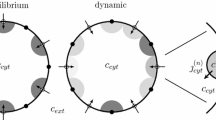Abstract
Markov modeling of conformational kinetics of cardiac ion channels is a prospective means to correlate the molecular defects of channel proteins to their electrophysiological dysfunction. However, both the identifiability of the microscopic conformations and the estimation of the transition rates are challenging. In this paper, we present a new method in which the distribution space of the time constants of exponential components of mathematical models are searched as an alternative to the consideration of transition rates. Transition rate patterns were defined and quasi random seed sequences for each pattern were generated by using a multiple recursive generator algorithm. Cluster-wide Monte Carlo simulation was performed to investigate various schemes of Markov models. It was found that by increasing the number of closed conformations the time constants were shifted to larger magnitudes. With the inclusion of inactivation conformation the time distribution was altered depending on the topology of the schemes. Further results demonstrated the stability of the morphology of time distributions. Our study provides the statistical evaluation of the time constant space of Markov schemes. The method facilities the identification of the underlying models and the estimation of parameters, hence is proposed for use in investigating the functional consequences of defective genes responsible for ion channel diseases.
Preview
Unable to display preview. Download preview PDF.
Similar content being viewed by others
References
Horn, R., Vandenberg, C.: Statistical Properties of Single Sodium Channels. J. Gen. Physiol. 84(4), 505–534 (1984)
Sanguinetti, M.C., et al.: Spectrum of HERG K+-Channel Dysfunction in an Inherited Cardiac Arrhythmia. PNAS 93(5), 2208–2212 (1996)
Antzelevitch, C., Shimizu, W.: Cellular Mechanisms Underlying the Long QT Syndrome. Curr. Opin. Cardiol. 17(1), 43–51 (2002)
Clancy, C.E., Rudy, Y.: Na+ Channel Mutation That Causes Both Brugada and Long-QT Syndrome Phenotypes: A Simulation Study of Mechanism. Circulation 105(10), 1208–1213 (2002)
Mazhari, R., et al.: Molecular Interactions Between Two Long-QT Syndrome Gene Products, HERG and KCNE2, Rationalized by In Vitro and In Silico Analysis. Circ. Res. 89(1), 33–38 (2001)
French, R.J., Horn, R.: Sodium Channel Gating Models, Mimics and Modifiers. Annu. Rev. Biophys. Bioeng. 12, 319–356 (1983)
Qin, F., Auerbach, A., Sachs, F.: A Direct Optimization Approach to Hidden Markov Modeling for Single Channel Kinetics. Biophys. J. 79(4), 1915–1927 (2000)
Gropp, W., Lusk, E., et al.: A High-Performance, Portable Implementation of the MPI Message-Passing Interface Standard. Parallel Computing 22(6), 789–828 (1996)
Glassy, M., et al.: GNU Scientific Library Reference Manual, 2nd edn. ISBN 0954161734
L’Ecuyer, P., Blouin, F., Coutre, R.: A Search for Good Multiple Recursive Random Number Generators. ACM Transactions on Modeling and Computer Simulation 3, 87–98 (1993)
Tseng, G.-N.: IKr: The hERG Channel. Journal of Molecular and Cellular Cardiology 33(5), 835–849 (2001)
Scanley, B., et al.: Kinetic Analysis of Single Sodium Channels from Canine Cardiac Purkinje Cells. J. Gen. Physiol. 95(3), 411–437 (1990)
Author information
Authors and Affiliations
Editor information
Editors and Affiliations
Rights and permissions
Copyright information
© 2006 Springer-Verlag Berlin Heidelberg
About this paper
Cite this paper
Wang, C., Krause, A., Nugent, C., Dubitzky, W. (2006). Markov Modeling of Conformational Kinetics of Cardiac Ion Channel Proteins. In: Maglaveras, N., Chouvarda, I., Koutkias, V., Brause, R. (eds) Biological and Medical Data Analysis. ISBMDA 2006. Lecture Notes in Computer Science(), vol 4345. Springer, Berlin, Heidelberg. https://doi.org/10.1007/11946465_11
Download citation
DOI: https://doi.org/10.1007/11946465_11
Publisher Name: Springer, Berlin, Heidelberg
Print ISBN: 978-3-540-68063-5
Online ISBN: 978-3-540-68065-9
eBook Packages: Computer ScienceComputer Science (R0)




